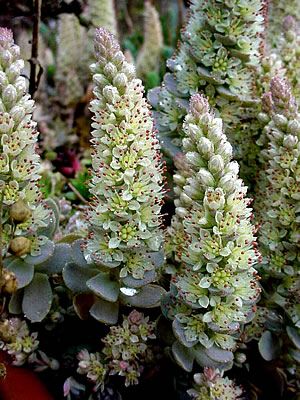The Chinese Dunce Cap, scientifically known as Orostachys boehmeri, is a stoloniferous succulent plant native to Japan. It is distinguished by its delicate, rounded leaf rosettes that resemble small flowers. The plant’s stolons are light-colored, glabrous, and grow horizontally in large numbers, with small rosettes forming at regular intervals of about 6 centimeters (2.36 inches), creating the appearance of an open, lace-like carpet.
The leaves are obovate to spatulate, firm, and gray in color, with hints of lilac or red. They form globular rosettes, somewhat dense, measuring 2.5 to 5 centimeters (1 to 2 inches) in diameter. Beginning in the second year after planting, the Chinese Dunce Cap blooms, typically in the autumn, with long, compact, erect, cone-shaped inflorescences emerging from the center of each rosette, featuring numerous cream-colored flowers. The rosettes that produce flowers die after blooming, but not before giving rise to new rosettes.

In landscaping and decor, O. boehmeri is a highly versatile succulent. It can be planted in pots and planters, which, when lined with it, become very charming. The stolons grow out of the pot, becoming pendulous and romantically beautiful. Thus, it is interesting to cultivate them in hanging pots and baskets, which can be admired from above.
Its small height and unusual grayish-purple color make it an excellent choice for compositions, used as ground cover and filler with other species, whether succulents, cacti, or plants suitable for low-water gardens. Such as terrariums, fairy gardens, succulent frames, and other mini compositions that are currently popular. In the outdoor garden, for the same reasons, it serves as ground cover, adding a delicate texture and contrasting color to other species.
Excellent for arid gardens, with a desert inspiration, and between rock walls and retaining walls. As it does not tolerate trampling, it is not suitable for use in pathways or high-traffic areas. It is easy to cultivate, even for beginner and forgetful gardeners.
It should be grown in a sunny location, whether in full sun or partial shade, in well-drained soil, and watered sparingly, allowing the soil to dry out between waterings. It is very sensitive to excess moisture, becoming susceptible to fungal and bacterial diseases. Water in the morning, avoiding wetting the leaves, so that any pooled water dissipates by night.
This species is quite cold-tolerant, able to survive temperatures below -34° Celsius (-29° Fahrenheit). During the winter, its growth halts, resuming in the spring. In very dry and hot climates, it thrives better in partial shade, while in temperate climates, it is best grown in full sun, resulting in denser, more beautiful rosettes. Propagation is easily done through leaf cuttings and separating the rosettes that form at each segment of the stolon.


